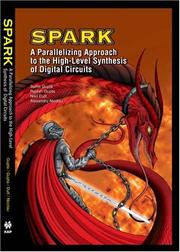| Listing 1 - 4 of 4 |
Sort by
|
Digital
ISBN: 9780387263991 Year: 2005 Publisher: Boston, MA Springer Science+Business Media, Inc
Abstract | Keywords | Export | Availability | Bookmark
 Loading...
Loading...Choose an application
- Reference Manager
- EndNote
- RefWorks (Direct export to RefWorks)
Electronics --- Electrical engineering --- Programming --- Computer architecture. Operating systems --- Artificial intelligence. Robotics. Simulation. Graphics --- Computer. Automation --- embedded systems --- informatica --- computerbesturingssystemen --- elektronica --- KI (kunstmatige intelligentie) --- CAD (computer aided design) --- architectuur (informatica) --- elektrische circuits --- AI (artificiële intelligentie)

ISBN: 9781402078378 1402078374 9781402078385 9786610609512 1280609516 1402078382 Year: 2004 Publisher: Boston (Mass.) : Kluwer academic,
Abstract | Keywords | Export | Availability | Bookmark
 Loading...
Loading...Choose an application
- Reference Manager
- EndNote
- RefWorks (Direct export to RefWorks)
Rapid advances in microelectronic integration and the advent of Systems-on-Chip have fueled the need for high-level synthesis, i.e., an automated approach to the synthesis of hardware from behavioral descriptions. SPARK: A Parallelizing Approach to the High - Level Synthesis of Digital Circuits presents a novel approach to the high-level synthesis of digital circuits -- that of parallelizing high-level synthesis (PHLS). This approach uses aggressive code parallelizing and code motion techniques to discover circuit optimization opportunities beyond what is possible with traditional high-level synthesis. This PHLS approach addresses the problems of the poor quality of synthesis results and the lack of controllability over the transformations applied during the high-level synthesis of system descriptions with complex control flows, that is, with nested conditionals and loops. Also described are speculative code motion techniques and dynamic compiler transformations that optimize the circuit quality in terms of cycle time, circuit size and interconnect costs. We describe the SPARK parallelizing high-level synthesis framework in which we have implemented these techniques and demonstrate the utility of SPARK's PHLS approach using designs derived from multimedia and image processing applications. We also present a case study of an instruction length decoder derived from the Intel Pentium-class of microprocessors. This case study serves as an example of a typical microprocessor functional block with complex control flow and demonstrates how our techniques are useful for such designs. SPARK: A Parallelizing Approach to the High - Level Synthesis of Digital Circuits is targeted mainly to embedded system designers and researchers. This includes people working on design and design automation. The book is useful for researchers and design automation engineers who wish to understand how the main problems hindering the adoption of high-level synthesis among designers.
Digital integrated circuits --- Parallel processing (Electronic computers) --- Circuits intégrés numériques --- Parallélisme (Informatique) --- Design and construction --- Data processing. --- Computer simulation. --- Conception et construction --- Informatique --- SPARK (Electronic resource) --- Computer engineering. --- Digital integrated circuits. --- Engineering. --- Parallel processing (Electronic computers). --- Systems engineering. --- Electrical Engineering --- Electrical & Computer Engineering --- Engineering & Applied Sciences --- Data processing --- Computer simulation --- Digital electronics. --- Electronic systems. --- Electrical engineering. --- Electronic circuits. --- Circuits and Systems. --- Electrical Engineering. --- Electric engineering --- Engineering --- Electron-tube circuits --- Electric circuits --- Electron tubes --- Electronics --- Digital electronics --- Integrated circuits

ISBN: 0792391942 9780792391944 Year: 1992 Publisher: Boston: Kluwer,
Abstract | Keywords | Export | Availability | Bookmark
 Loading...
Loading...Choose an application
- Reference Manager
- EndNote
- RefWorks (Direct export to RefWorks)
Integrated circuits --- Silicon compilers --- Very large scale integration --- Computer-aided design --- Very large scale integration of circuits --- VLSI circuits --- Compilation, Silicon --- Compilers, Silicon --- Silicon compilation --- Compilers (Computer programs) --- Very large scale integration. --- Chips (Electronics) --- Circuits, Integrated --- Computer chips --- Microchips --- Electronic circuits --- Microelectronics --- Very large scale integration&delete& --- Integrated circuits - Very large scale integration - Computer-aided design
Book
ISBN: 9780387263991 Year: 2005 Publisher: Boston MA Springer US
Abstract | Keywords | Export | Availability | Bookmark
 Loading...
Loading...Choose an application
- Reference Manager
- EndNote
- RefWorks (Direct export to RefWorks)
Validation of programmable architectures, consisting of processor cores, coprocessors, and memory subsystems, is one of the major bottlenecks in current System-on-Chip design methodology. A critical challenge in validation of such systems is the lack of a golden reference model. As a result, many existing validation techniques employ a bottom-up approach to design verification, where the functionality of an existing architecture is, in essence, reverse-engineered from its implementation. Traditional validation techniques employ different reference models depending on the abstraction level and verification task, resulting in potential inconsistencies between multiple reference models. This book presents a top-down validation methodology that complements the existing bottom-up approaches. It leverages the system architect's knowledge about the behavior of the design through architecture specification using an Architecture Description Language (ADL). The authors also address two fundamental challenges in functional verification: lack of a golden reference model, and lack of a comprehensive functional coverage metric. Functional Verification of Programmable Embedded Architectures: A Top-Down Approach is designed for students, researchers, CAD tool developers, designers, and managers interested in the development of tools, techniques and methodologies for system-level design, microprocessor validation, design space exploration and functional verification of embedded systems.
Electronics --- Electrical engineering --- Programming --- Computer architecture. Operating systems --- Artificial intelligence. Robotics. Simulation. Graphics --- Computer. Automation --- embedded systems --- informatica --- computerbesturingssystemen --- elektronica --- KI (kunstmatige intelligentie) --- CAD (computer aided design) --- architectuur (informatica) --- elektrische circuits
| Listing 1 - 4 of 4 |
Sort by
|

 Search
Search Feedback
Feedback About UniCat
About UniCat  Help
Help News
News